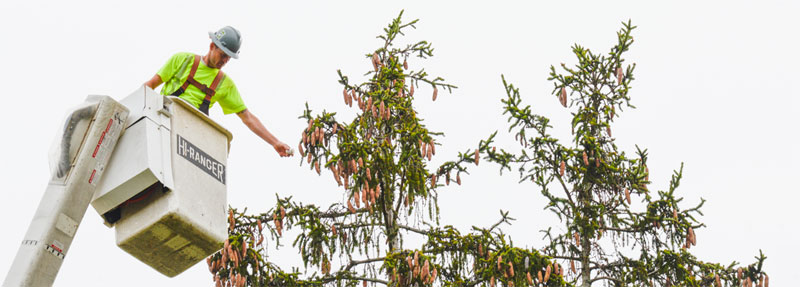Predatory helpers
Facilities Management landscapers use predatory insects to control infestations

The harmful spruce mites damaging a string of spruce trees along Cemetery Drive are barely visible to the human eye, and yet they can do a lot of damage. When an insect population gets out of control and has no naturally-occurring predators, extensive deterioration to foliage can eventually lead to widespread destruction of the tree.
While sometimes chemical treatments are used to control infestations, Facilities Management Plant Health Care Specialist Mike Henrietta has been regularly using a different method — predatory insects.
“This reduces our need for non-selective pesticides, which can kill natural predators as well as the target pest,” according to Landscape Superintendent Rich Hopkins.
Henrietta works with IPM Laboratories, Inc. of Locke, N.Y. to identify which insect infestations of certain trees, shrubs and grasses may be best tackled by releasing predatory insects.
In mid-April, a batch of predatory mites (the species neoseiulus fallacis) was released into the tops of the approximately 75-foot-tall Cemetery Drive spruce trees with the help of Big “O” Tree & Lawn of Stuarts Draft. A recent sample of these trees pinpointed their age at over 100 years old.
“I think they’re worth saving. We have some rare trees,” Henrietta said of the spruces.
Using both a bucket truck and climbing equipment, the contractors dispensed one to two small containers of about 1,000 microscopic mites per tree.
Once the mites settle onto the branches, they don’t travel very far but will continue to multiply as long as their prey is available to eat. Henrietta will eventually check on the health of the tree by inspecting foliage for damage and tapping it over a plain white sheet of paper. If the harmful spruce mites are still infesting the tree, they will fall off of the foliage onto the paper and can be spotted using a hand lens.
In addition to the environmental benefits of reducing chemicals released into the soil, the use of predatory insects can be less expensive. Each container of these predatory mites costs about $12, which is cheaper than the cost of a pesticide treatment for a tree of that same size.
“We are way down on toxins on Grounds and it’s no more expensive,” Henrietta said. Plus, the Facilities Management staff member has found that certain predatory insect releases are shown to be more effective and do not require follow-up treatments. Six years ago, Henrietta treated a white grub infestation in the grass near Peadbody Hall using a predatory worm called a nematode. Since then, the white grub population has stayed under control and the area has not required retreatment.
While the use of predatory insects in commercial landscaping is relatively uncommon (with most applications occurring in greenhouses and in residential landscaping), the Facilities Management Landscape team continues to pursue opportunities to expand its use of this progressive treatment — saving the environment, reducing expenses and preserving our beautiful Grounds.
Jane DeGeorge
Communications Generalist
Human Resources & Training
UVA Facilities Management
(434)982-5846
jad2tm@virginia.edu